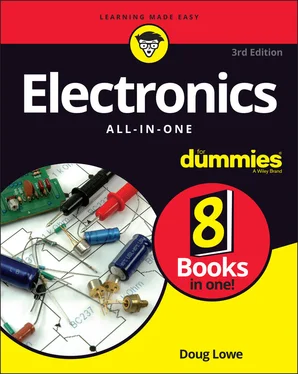Doug Lowe - Electronics All-in-One For Dummies
Здесь есть возможность читать онлайн «Doug Lowe - Electronics All-in-One For Dummies» — ознакомительный отрывок электронной книги совершенно бесплатно, а после прочтения отрывка купить полную версию. В некоторых случаях можно слушать аудио, скачать через торрент в формате fb2 и присутствует краткое содержание. Жанр: unrecognised, на английском языке. Описание произведения, (предисловие) а так же отзывы посетителей доступны на портале библиотеки ЛибКат.
- Название:Electronics All-in-One For Dummies
- Автор:
- Жанр:
- Год:неизвестен
- ISBN:нет данных
- Рейтинг книги:5 / 5. Голосов: 1
-
Избранное:Добавить в избранное
- Отзывы:
-
Ваша оценка:
- 100
- 1
- 2
- 3
- 4
- 5
Electronics All-in-One For Dummies: краткое содержание, описание и аннотация
Предлагаем к чтению аннотацию, описание, краткое содержание или предисловие (зависит от того, что написал сам автор книги «Electronics All-in-One For Dummies»). Если вы не нашли необходимую информацию о книге — напишите в комментариях, мы постараемся отыскать её.
Electronics All-in-One For Dummies,
Electronics All-in-One For Dummies
Electronics All-in-One For Dummies — читать онлайн ознакомительный отрывок
Ниже представлен текст книги, разбитый по страницам. Система сохранения места последней прочитанной страницы, позволяет с удобством читать онлайн бесплатно книгу «Electronics All-in-One For Dummies», без необходимости каждый раз заново искать на чём Вы остановились. Поставьте закладку, и сможете в любой момент перейти на страницу, на которой закончили чтение.
Интервал:
Закладка:
25 Book 5 Chapter 3FIGURE 3-1: A transistor NOT gate.FIGURE 3-2: A transistor NOT gate assembled on a breadboard (Project 31).FIGURE 3-3: A transistor AND gate.FIGURE 3-4: A transistor NAND gate.FIGURE 3-5: A two-transistor NAND gate on a breadboard (Project 32).FIGURE 3-6: A transistor OR gate.FIGURE 3-7: A transistor NOR gate.FIGURE 3-8: A two-transistor NOR gate on a breadboard (Project 33).FIGURE 3-9: A typical TTL gate.FIGURE 3-10: Pinout chart for 4000-series Quad Two-Input Logic Gate chips.FIGURE 3-11: A NAND gate circuit that uses a CMOS logic chip (Project 34).
26 Book 5 Chapter 4FIGURE 4-1: Schematic diagram for an active-high latch.FIGURE 4-2: Schematic diagram for an active-low latch.FIGURE 4-3: The assembled active-high latch (Project 38).FIGURE 4-4: The assembled active-low latch (Project 39).FIGURE 4-5: A latch in which  is active-low and RESET is active-high.FIGURE 4-6: A gated SR latch.FIGURE 4-7: A gated D latch.FIGURE 4-8: The assembled gated D latch (Project 40).FIGURE 4-9: A circuit that detects a clock transition.FIGURE 4-10: The assembled D flip-flop circuit (Project 41).FIGURE 4-11: The assembled T flip-flop circuit (Project 42).
is active-low and RESET is active-high.FIGURE 4-6: A gated SR latch.FIGURE 4-7: A gated D latch.FIGURE 4-8: The assembled gated D latch (Project 40).FIGURE 4-9: A circuit that detects a clock transition.FIGURE 4-10: The assembled D flip-flop circuit (Project 41).FIGURE 4-11: The assembled T flip-flop circuit (Project 42).
27 Book 5 Chapter 5FIGURE 5-1: Schematic for an LED circuit connected to a microcontroller I/O pin...
28 Book 6 Chapter 1FIGURE 1-1: An Arduino UNO.FIGURE 1-2: Components of an Arduino UNO.FIGURE 1-3: The Arduino IDE.FIGURE 1-4: The Blink program ready to run.FIGURE 1-5: The headers on an UNO board.FIGURE 1-6: Adding an external LED to an UNO board.FIGURE 1-7: The assembled Arduino LED circuit (Project 43).
29 Book 6 Chapter 2FIGURE 2-1: The prototyping shield snaps into the top of an Arduino UNO.FIGURE 2-2: Identifying the connections on a prototyping shieldFIGURE 2-3: An Arduino UNO with eight LEDs on a prototyping shield (Project 44)...
30 Book 6 Chapter 3FIGURE 3-1: Active-high and active-low input circuits.FIGURE 3-2: A circuit for testing an active-high push button switch (Project 45...FIGURE 3-3: Connecting a pot to an Arduino I/O pin.FIGURE 3-4: A circuit that uses a potentiometer to control flashing LEDs (Proje...
31 Book 6 Chapter 4FIGURE 4-1: An HC-SR04 Range Finder.FIGURE 4-2: A typical 2 x 16 LCD.FIGURE 4-3: The assembled Arduino proximity sensor (Project 47).
32 Book 6 Chapter 5FIGURE 5-1: The piezoelectric speaker that comes with the Arduino Activity Kit.FIGURE 5-2: Connecting a speaker or buzzer to an Arduino digital output pin.FIGURE 5-3: Screw-terminal breakout shields that make it easy to connect strand...FIGURE 5-4: A speaker connected to an Arduino (Project 48).FIGURE 5-5: The Adafruit Music Maker shield.FIGURE 5-6: The Library Manager dialog box.FIGURE 5-7: An Arduino Music Player (Project 49).FIGURE 5-8: A typical hobby servo.FIGURE 5-9: Connecting a servo to an Arduino.FIGURE 5-10: A three-pin header adapter for connecting the servo to an Arduino.FIGURE 5-11: An Arduino project that controls a servo (Project 50).
33 Book 6 Chapter 6FIGURE 6-1: A typical keypad.FIGURE 6-2: How the push buttons are connected in a keypad.FIGURE 6-3: The Library Manager dialog box.FIGURE 6-4: Monitoring the serial output from the keypad program.FIGURE 6-5: An Arduino Leonardo board.
34 Book 7 Chapter 1FIGURE 1-1: A Raspberry Pi 4.FIGURE 1-2: The Raspberry Pi Imager program.FIGURE 1-3: Choose an operating system.FIGURE 1-4: Choose your SD card.FIGURE 1-5: The initial configuration for the Raspberry Pi OS.FIGURE 1-6: The Raspberry Pi Desktop.FIGURE 1-7: The Thonny Python IDE.FIGURE 1-8: Thonny in regular mode, with menus!FIGURE 1-9: The hello.py program.FIGURE 1-10: The Hello, World! Program in action.FIGURE 1-11: Raspberry Pi header pins.FIGURE 1-12: Connecting an LED to a GPIO port.FIGURE 1-13: The Raspberry Pi LED Flasher (Project 51).
35 Book 7 Chapter 2FIGURE 2-1: A Raspberry Pi test circuit with eight LEDs (Project 52).
36 Book 7 Chapter 3FIGURE 3-1: Active-high and active-low input circuits.FIGURE 3-2: A circuit for testing an active-high push-button switch (Project 53...FIGURE 3-3: Pinout for the MCP3008 analog-to-digital converter.FIGURE 3-4: Using an MCP3008 to connect a potentiometer to a Raspberry Pi.FIGURE 3-5: The Raspberry Pi Software Configuration Tool.FIGURE 3-6: The Interface Options page.FIGURE 3-7: Using a potentiometer to control flashing LEDs (Project 54).
37 Book 8 Chapter 1FIGURE 1-1: The completed color organ project.FIGURE 1-2: Connecting the color organ to a light and a sound source.FIGURE 1-3: The schematic diagram for the color organ circuit.FIGURE 1-4: The assembled Velleman MK110 kit.FIGURE 1-5: Drill the holes as indicated in this diagram.FIGURE 1-6: How the parts go together inside the project box.FIGURE 1-7: The color organ is almost finished.
38 Book 8 Chapter 2FIGURE 2-1: The basic ShowTime PC controller from Light-O-Rama.FIGURE 2-2: A basic setup for a 16-channel ShowTime PC Light-O-Rama controller.FIGURE 2-3: Assembling the ShowTime PC circuit board.FIGURE 2-4: A USB adapter converts the RS-485 protocol required by the ShowTime...FIGURE 2-5: The Light-O-Rama Hardware program.FIGURE 2-6: The Hardware program’s Console lets you test your controller channe...FIGURE 2-7: A simple Light-O-Rama sequence.FIGURE 2-8: Choosing the type of sequence to create.FIGURE 2-9: Filling in the musical sequence options.FIGURE 2-10: A blank sequence.FIGURE 2-11: Changing the name or color of a row.FIGURE 2-12: Displaying the waveform.FIGURE 2-13: The Animation window.FIGURE 2-14: The Animation window with a background picture.FIGURE 2-15: The Animation window with lights drawn in.
39 Book 8 Chapter 3FIGURE 3-1: The jack-in-the-box prop.FIGURE 3-2: The lift mechanism.FIGURE 3-3: Schematic diagram for the jack-in-the-box prop.FIGURE 3-4: The assembled animatronic prop controller.FIGURE 3-5: Where to mount the circuit boards and drill the mounting holes for ...
40 Book 8 Chapter 4FIGURE 4-1: Robby the Robot from Forbidden Planet FIGURE 4-2: Robot B-9 from Lost in Space. FIGURE 4-3: VIN-e, version 1.FIGURE 4-4: The solar-powered yard lamp I used as the central pillar in VIN-e.FIGURE 4-5: Bits and pieces used to support VIN-e’s mouth and “vacuum tubes.”FIGURE 4-6: An Arduino MEGA board.FIGURE 4-7: An eight-channel relay board.FIGURE 4-8: A covered terminal strip safely routes 120 VAC power for the projec...
Guide
1 Cover
2 Title Page
3 Copyright
4 Table of Contents
5 Begin Reading
6 Index
7 About the Author
Pages
1 i
2 ii
3 1
4 2
5 3
6 4
7 5
8 7
9 8
10 9
11 10
12 11
13 12
14 13
15 14
16 15
17 16
18 17
19 18
20 19
21 20
22 21
23 22
24 23
25 24
26 25
27 26
28 27
29 28
30 29
31 30
32 31
33 32
34 33
35 34
36 35
37 36
38 37
39 38
40 39
41 40
42 41
43 42
44 43
45 44
46 45
47 46
48 47
49 48
50 49
51 50
52 51
53 52
54 53
55 54
56 55
57 56
58 57
59 58
60 59
61 60
62 61
63 62
64 63
65 64
66 65
67 66
68 67
69 68
70 69
71 70
72 71
73 72
74 73
75 74
76 75
77 76
78 77
79 78
80 79
81 80
82 81
83 82
84 83
85 85
86 86
87 87
88 88
89 89
90 90
91 91
92 92
93 93
94 94
95 95
96 96
97 97
98 98
99 99
100 100
101 101
102 102
103 103
104 104
105 105
Читать дальшеИнтервал:
Закладка:
Похожие книги на «Electronics All-in-One For Dummies»
Представляем Вашему вниманию похожие книги на «Electronics All-in-One For Dummies» списком для выбора. Мы отобрали схожую по названию и смыслу литературу в надежде предоставить читателям больше вариантов отыскать новые, интересные, ещё непрочитанные произведения.
Обсуждение, отзывы о книге «Electronics All-in-One For Dummies» и просто собственные мнения читателей. Оставьте ваши комментарии, напишите, что Вы думаете о произведении, его смысле или главных героях. Укажите что конкретно понравилось, а что нет, и почему Вы так считаете.












